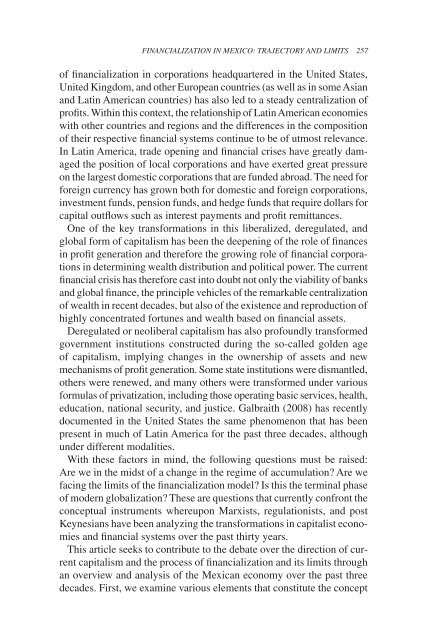Financialization in Mexico - Dr. Gregorio Vidal
Financialization in Mexico - Dr. Gregorio Vidal
Financialization in Mexico - Dr. Gregorio Vidal
Create successful ePaper yourself
Turn your PDF publications into a flip-book with our unique Google optimized e-Paper software.
FINANCIALIzATION IN MEXICO: TRAJECTORY AND LIMITS 257<br />
of f<strong>in</strong>ancialization <strong>in</strong> corporations headquartered <strong>in</strong> the United States,<br />
United K<strong>in</strong>gdom, and other European countries (as well as <strong>in</strong> some Asian<br />
and Lat<strong>in</strong> American countries) has also led to a steady centralization of<br />
profits. With<strong>in</strong> this context, the relationship of Lat<strong>in</strong> American economies<br />
with other countries and regions and the differences <strong>in</strong> the composition<br />
of their respective f<strong>in</strong>ancial systems cont<strong>in</strong>ue to be of utmost relevance.<br />
In Lat<strong>in</strong> America, trade open<strong>in</strong>g and f<strong>in</strong>ancial crises have greatly damaged<br />
the position of local corporations and have exerted great pressure<br />
on the largest domestic corporations that are funded abroad. The need for<br />
foreign currency has grown both for domestic and foreign corporations,<br />
<strong>in</strong>vestment funds, pension funds, and hedge funds that require dollars for<br />
capital outflows such as <strong>in</strong>terest payments and profit remittances.<br />
One of the key transformations <strong>in</strong> this liberalized, deregulated, and<br />
global form of capitalism has been the deepen<strong>in</strong>g of the role of f<strong>in</strong>ances<br />
<strong>in</strong> profit generation and therefore the grow<strong>in</strong>g role of f<strong>in</strong>ancial corporations<br />
<strong>in</strong> determ<strong>in</strong><strong>in</strong>g wealth distribution and political power. The current<br />
f<strong>in</strong>ancial crisis has therefore cast <strong>in</strong>to doubt not only the viability of banks<br />
and global f<strong>in</strong>ance, the pr<strong>in</strong>ciple vehicles of the remarkable centralization<br />
of wealth <strong>in</strong> recent decades, but also of the existence and reproduction of<br />
highly concentrated fortunes and wealth based on f<strong>in</strong>ancial assets.<br />
Deregulated or neoliberal capitalism has also profoundly transformed<br />
government <strong>in</strong>stitutions constructed dur<strong>in</strong>g the so-called golden age<br />
of capitalism, imply<strong>in</strong>g changes <strong>in</strong> the ownership of assets and new<br />
mechanisms of profit generation. Some state <strong>in</strong>stitutions were dismantled,<br />
others were renewed, and many others were transformed under various<br />
formulas of privatization, <strong>in</strong>clud<strong>in</strong>g those operat<strong>in</strong>g basic services, health,<br />
education, national security, and justice. Galbraith (2008) has recently<br />
documented <strong>in</strong> the United States the same phenomenon that has been<br />
present <strong>in</strong> much of Lat<strong>in</strong> America for the past three decades, although<br />
under different modalities.<br />
With these factors <strong>in</strong> m<strong>in</strong>d, the follow<strong>in</strong>g questions must be raised:<br />
Are we <strong>in</strong> the midst of a change <strong>in</strong> the regime of accumulation? Are we<br />
fac<strong>in</strong>g the limits of the f<strong>in</strong>ancialization model? Is this the term<strong>in</strong>al phase<br />
of modern globalization? These are questions that currently confront the<br />
conceptual <strong>in</strong>struments whereupon Marxists, regulationists, and post<br />
Keynesians have been analyz<strong>in</strong>g the transformations <strong>in</strong> capitalist economies<br />
and f<strong>in</strong>ancial systems over the past thirty years.<br />
This article seeks to contribute to the debate over the direction of current<br />
capitalism and the process of f<strong>in</strong>ancialization and its limits through<br />
an overview and analysis of the Mexican economy over the past three<br />
decades. First, we exam<strong>in</strong>e various elements that constitute the concept


